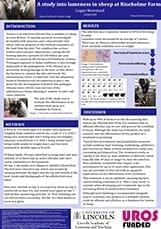by Logan Newstead

My hopes after finishing my degree are to pursue a PhD and career in research, and so undertaking a UROS project has been invaluable in helping me to achieve this.
Supervised by Dr Clegg, I conducted a study into lameness in sheep. This was a unique experience as not only was I working in the laboratory, but also got the opportunity to spend two weeks doing field work at Riseholme Farm. Getting to be involved in every aspect of the research, from handling the animals and collecting the samples to culturing them in the lab really adds another dimension to the way I look at the results!
My UROS project has allowed me to develop vital skills that will benefit me as I progress through my degree and subsequent career; I was involved in project design and had to work independently and efficiently. I also found it incredibly useful to have the chance to work in the JBL laboratories, following the correct protocols and learning my way around, as this is where I will be carrying out my third year project.
In the laboratory I was able to practise and improve techniques such as DNA extraction, PCR and gel electrophoresis; these are used to amplify DNA from an unknown organism in order to identify it.
We collected faecal samples and foot swabs from lame and non-lame sheep at the farm and cultured these to look for any difference in the microorganisms found. In addition to this, we also carried out a clinical trial on the lame lambs with suspected footrot at the farm.
Footrot is caused by the bacteria Fusobacterium necrophorum, which infects the skin between the digits, causing lesions, inflammation and a foul smell, and eventually damages the hoof completely. Footrot is more commonly seen in very damp conditions, but can spread very quickly through a flock, especially if there is prior damage or injury to the hooves.
We identified and isolated 44 lame lambs from the total flock of 193. All lambs were weighed and body condition scores from 1-5 (with 1 being very underweight and 5 being very overweight), and lame lambs were given a lameness score of 1-5 (1 being fine, 5 being totally unable to weight-bear). Of the 44 lame lambs, 24 had an active infection and were viable candidates for being treated. The treatment was applied a total of 4 times, at 3 day intervals, by spraying directly onto the effected foot. The feet were rechecked daily, and given a final lameness score after the trial was complete.
Overall, the UROS experience is very well organised and supported, allowing students to get a taste for independent research, which is beneficial whether wanting to continue on into academic research, or as preparation for third year projects.
*To view Logan’s project poster, please click on the thumbnail below:

